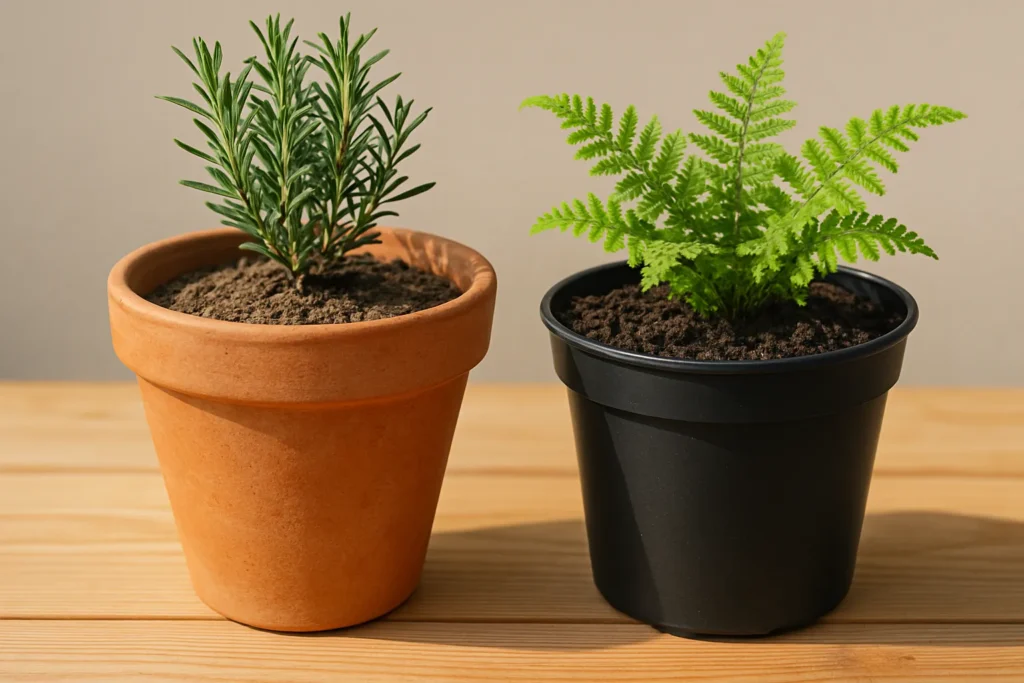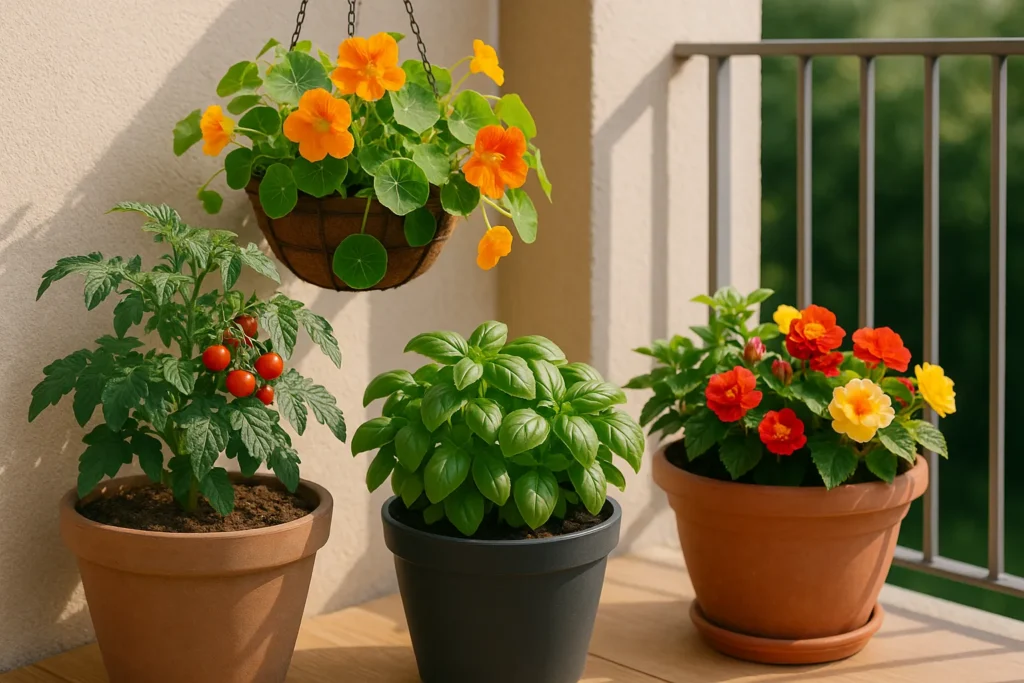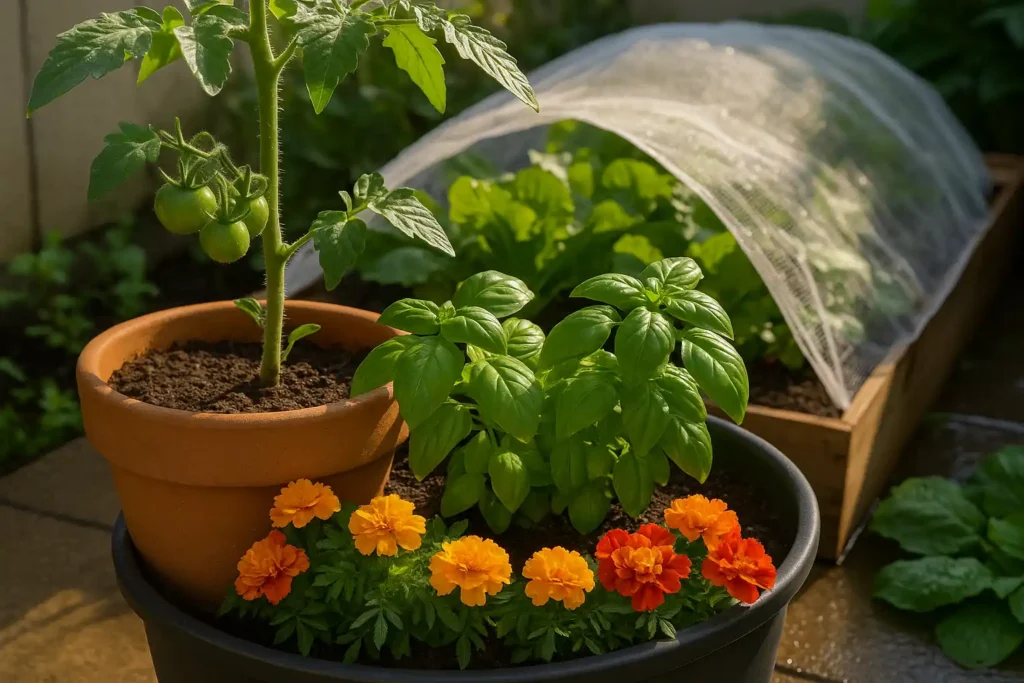Have you ever looked at your tiny patio or balcony and thought, “Where on earth would I put a garden?” We get you.
But with the right ideas, like vertical gardening and container planting, you can turn even the tightest corner into a green, blooming haven.
In this post, you’ll learn how to create a strategic garden layout, use height to your advantage, choose the best pots and plants, and keep everything healthy with simple maintenance. You’ll also get tips on how to avoid plant crowding or poor drainage.
Time to pull up a chair and reimagine the possibilities for your little garden space. Let’s get started.
Brilliant Vertical Gardening Ideas That Save Space
Vertical gardening means using height to grow plants when ground space is limited. It’s a clever way to turn fences, walls, and shelves into productive planting zones. This method is perfect for small spaces like balconies and patios where every bit of room counts.
This gardening approach involves raising plants off the ground. It saves space and improves the plants’ access to sunlight. It also boosts air circulation around all sides, which lowers the risk of rot and mildew and keeps your plants healthier.
Vertical gardens also bring structure and colour to plain walls. It makes them both practical and attractive.
There are plenty of DIY vertical planters to try:
- Wall-mounted pots: These are excellent for herbs and flowering plants that grow well in shallow soil. You can find them for around $12 to $50, depending on the design and what they’re made from.
- Trellises: Ideal for supporting climbers like cucumbers, sweet peas, and runner beans. Basic models start around $24, with decorative options reaching up to $99.
- Garden towers: These compact vertical systems are perfect for leafy greens and herbs with minimal space. Entry-level hydroponic towers begin at $128, while premium models can go up to $799.
- Recycled wooden pallets: They can hold small containers with lettuce, strawberries, thyme, and other shallow-rooted plants. They are often available for free or at low cost from local suppliers.
- Freestanding ladders with wide steps: A renter-friendly option that adds vertical levels without permanent fixtures. Prices vary widely, from around $30 for basic models to over $100 for designer pieces.
For vertical garden plants, choose ones that naturally grow up or hang down. Cherry tomatoes, peas, and climbing nasturtiums grow upward and produce generously.
Meanwhile, strawberries, thyme, and mint trail neatly over the edge of pots. These types generally thrive in vertical setups without needing a lot of deep soil.
Mini tip: Always ensure your tall planters or garden towers are securely anchored. A sudden strong wind can easily topple things otherwise.
Let’s now look at how container planting adds flexibility and structure to any small garden, especially when combined with vertical ideas.
Strategic Container Planting Tips for Small Gardens
Container planting gives you flexibility, control, and structure. It works well for small spaces. With the right choices, pots become mobile and adaptable growing zones. You can move pots with the seasons, group them by plant type, or lift them vertically to create depth.

Here’s how to use containers cleverly for better results in tight spots.
Best Containers for Small Garden Plants
The pot you choose can directly influence how well your plant grows. It affects drainage, root space, temperature, and water control. Matching the right container to your plant makes maintenance easier and growth more consistent.
Why Drainage and Pot Depth Matter
Good drainage is vital for any potted plant to grow. That’s why you need drainage holes. If they’re not there, excess water will just sit at the bottom of the pot. It’ll suffocate the roots, which will inevitably lead to root rot.
And every plant needs the right pot depth. If the pot is too shallow, the roots will hit the bottom too quickly and become cramped. On the other hand, if it’s too deep, you’ll end up using more compost than necessary.
Terracotta vs Plastic Pots: What to Choose
Terracotta and plastic pots both have their advantages and downsides. The terracotta pots “breathe” well and allow air and moisture to pass through their walls. This feature makes them excellent for Mediterranean herbs and plants that prefer drier conditions. However, it also means they dry out faster.
In comparison, plastic pots are non-porous and hold onto water for longer periods. This makes them a better choice for plants that love consistently moist soil. They’re also generally lighter and often more affordable.
Use this table to make your choice:
| Feature | Terracotta | Plastic |
| Weight | Heavier, stable in wind | Lightweight, easier to move |
| Water retention | Porous, dries faster | Holds water longer |
| Durability | Can crack in cold or drop impact | Weather-resistant |
| Look | Earthy, traditional garden style | Modern, colourful, mixes with décor |
| Price Range | $2 – $80 | $1 – $40 |
Ideal Pot Sizes for Different Plant Types
Plants rely on root space to grow properly. So, smaller species need less depth, while bushier types demand wider pots.
You can follow this general guide below for pot sizes:
- Herbs (e.g., mint, chives): Pots 15-20 cm in size suit them well. Expect to pay around $2 to $10.
- Chillies and lettuce: These plants grow well in 25-30 cm containers. They typically cost between $10 and $30.
- Dwarf citrus trees: They require pots that are 40 cm or larger for the best results. Prices for these pots range from $30 to $80.
Useful Ways to Position Your Containers
Good placement allows plants to grow stronger and stay healthier. It also makes watering and harvesting easier. And if you know how to work with light and space, it can considerably improve your results.
We’ll show you how to purposefully arrange your containers for the best outcome.
Use Sunlight and Height to Maximise Growth
Arranging your pots by height ensures taller plants do not block the light from smaller ones.
- Rail-hanging baskets: These are brilliant for herbs and fruiting plants like strawberries.
- Tiered stands: They help you layer herbs and leafy greens efficiently in compact areas.
- Tall containers: Position these near sunny edges to avoid casting shade on smaller plants.
How to Make Containers Easier to Move
Seasonal changes affect where light and shade fall. That’s why movable containers help you adjust without disturbing roots.
You can use wheeled pot trolleys that let you move larger pots with ease. They typically cost between $10 and $20, depending on their quality and size.
Choosing the Right Soil for Container Planting
Healthy plants begin with good soil. In pots, this means using a soil that holds moisture without becoming waterlogged. It also provides a steady supply of nutrients for growth.
Choosing the right mix makes a noticeable difference in how healthy your plants are. George, a newly passionate gardener from Melbourne, recently swapped out regular garden soil for a light potting mix with compost and perlite. Within weeks, his chilli plants doubled in size and stopped wilting in the afternoon sun.
Follow the tips here to set up your plants properly and get results similar to George’s.
Layering Tips for Healthy Roots and Drainage
Container soil should be built in layers to ensure good structure and airflow.
- Base layer: Start with 3-5 cm of gravel or clay pellets to stop water from pooling at the bottom.
- Potting mix: Use a mixture specifically designed for container planting. A 25-litre bag typically costs between $5 and $10.
- Compost: This boosts the nutrients available to your plants and helps the soil retain moisture. A 25-litre bag usually costs $6 to $10.
Top Crops That Thrive in Containers
Some plants handle container life better than others. They are compact, efficient with space, and often easier to maintain. These choices grow reliably in pots and suit a range of conditions.
Easy and Productive Plants for Pots
These plants are the top performers for small gardens:
- Lettuce: Grows quickly and only needs shallow soil. You can harvest it several times.
- Chillies: Prefer warm conditions and work well in snug containers.
- Herbs (basil, thyme, mint): These herbs have continuous growth and suit various pot sizes. But mint prefers its own space, as it can spread aggressively.
- Succulents: They are perfect for dry corners and sunny spots. They require minimal care.
- Dwarf citrus trees: These plants are compact and productive with the right care. Just ensure they get enough sun and are planted in a deep pot.
Best Plants for Small Space Gardening Success
After discussing containers, positioning, and soil, let’s turn our attention to the plants themselves. Choosing suitable plants is important as they help your garden flourish without crowding.
In compact areas, each choice should serve a purpose: providing yield, adding visual charm, or requiring low maintenance.

You’ll now find out which plants are perfect for making your small garden both productive and pretty.
Fast-Growing or Compact: What Fits Your Garden Best
In small gardens, you either want speed or space-saving structure. Fast-growing plants provide quicker rewards, while compact plants make it easier to layer your setup.
So, the right plant for you depends on your garden’s layout and how much time you want to spend on it.
Compare these two types below to see which fits best.
| Feature | Fast-Growing Plants | Compact Plants |
| Space Required | Moderate to high | Low |
| Ideal for | Quick harvests, rotating crops | Consistent spots, smaller containers |
| Examples | Lettuce, radish, rocket | Mint, thyme, chives, baby spinach |
| Care Level | Needs trimming and sunlight balance | Easier once established |
Easy Plants for Pots That Grow Themselves
If you’re after something reliable and low-maintenance, these plants practically grow themselves. They’re suitable for gardeners who are short on time or just starting out. These plants handle missed waterings and imperfect conditions with surprising grace.
Here’s a quick list of the top contenders:
- Mint: This one’s vigorous and fragrant, but it’s best kept in its own pot to stop it from spreading everywhere.
- Chives: Hardy and forgiving, they regrow nicely after a trim.
- Lettuce: Super quick to harvest and absolutely thrives in shallow containers.
- Cherry tomatoes: Look for compact varieties. They flourish in full sun with just a bit of support.
- Begonias: These are brilliant for adding colour, tolerate a bit of shade, and don’t demand constant watering.
Balcony-Friendly Plants That Look Good and Taste Great
Certain plants genuinely don’t force you to choose between beauty and practicality. They add loads of charm while also pulling their weight in the kitchen.
Explore this lovely mix of visual appeal and everyday usefulness below.
- Lavender: This one is drought-tolerant, great for pollinators, and has a wonderfully calming scent.
- Nasturtium: You get bright, edible flowers and trailing leaves from them. They are perfect for hanging baskets or other trailing setups.
- Basil: This plant grows quickly and enhances both your dishes and the look of your planter displays.
- Marigold: These vibrant blooms deter pests and fill small corners well.
Plants to Avoid in Small Space Gardens
You must choose your plants carefully to avoid wasted time and the need for replanting them in the future. That’s why knowing which plants demand too much room or nutrients or will cause you trouble is important.
Here’s a list of those plant types.
- Invasive rooters: Think about bamboo and uncontained mint. They can swiftly take over even large plots.
- Heavy feeders: Plants like pumpkins and corn will rapidly deplete the soil in small containers.
- Pest magnets: Cabbage and kale often draw pests without room for companion planting.
Mini tip: Always look for plants that naturally grow upwards or have shallow roots to simplify your container setup.
Easy Garden Maintenance Tips for Small Areas
Proper maintenance habits are vital for keeping small gardens booming with less effort. When space is limited, regular care can prevent common problems like tired soil, wilting, or overcrowded roots.
These low-effort practices below will keep your garden healthy, week by week.
Watering Routines for Healthy Container Plants
Watering correctly can be the difference between flourishing greenery and dried-up leaves. Containers dry out faster than in-ground beds, so your approach needs to match pot size, weather, and timing.
Implement these tips to keep your plants healthy.
Frequency by Container Type
- Small containers: These often dry out within hours, especially if they’re in full sun. Daily checks will help avoid dehydration.
- Large containers: These hold moisture for longer. You’ll likely need to water every 2 to 3 days, depending on the temperature and how well they drain.
Optimal Time of Day
- Morning: This helps plants absorb water before the heat of the day arrives. It also reduces stress on the plant.
- Late afternoon: This period works if mornings aren’t practical for you. Just try to avoid watering at night to prevent mould and mildew from setting in.
Climate Considerations
- Hot and dry areas: You’ll need to increase the frequency of watering and check the soil daily.
- Cooler, shaded areas: Reduce watering and monitor moisture levels to prevent root rot.
Fertilising Small Gardens Effectively
Pots tend to lose nutrients fast, so regular feeding is important to keep your plants productive and looking green. The trick is using the right type of fertilisers in the correct amount and getting the timing right for it.
When and How Much
- At planting: Mix in a slow-release fertiliser when you first put your plants in. This gives them steady nourishment over time.
- During growth: Add a liquid fertiliser every two to four weeks. The exact frequency will depend on what you’re growing and the type of soil you’re using.
Natural Fertiliser Options
- Compost tea: This feeds the microbes in your soil and helps strengthen your plants’ roots.
- Seaweed extract: Supports stress tolerance and root development.
- Fish emulsion: This is high in nitrogen. It’s fantastic for leafy herbs and greens.
Pest Control Strategies for Small Gardens
Even small gardens can attract pests, but you certainly don’t need harsh sprays to deal with them. There are easier, safer ways to manage them effectively.

Here’s how to keep bugs in check.
Companion Planting
Companion planting is growing specific plants close to each other to help them benefit mutually. They deter pests or attract helpful insects that lead to healthier growth. We’ll use them here to save our small gardens from pests.
- Marigolds: These are brilliant for repelling nematodes and certain beetles.
- Basil: It helps deter flies and can even improve the health of nearby tomato plants.
- Chives: These are good at fending off aphids and harmful larvae.
Natural Sprays
- Neem oil: This works well for controlling common pests like mites and whiteflies.
- Garlic spray: This spray acts as a natural repellent for many different insects.
Physical Barriers
- Mulching: This helps keep roots cool and the soil nice and moist.
- Repositioning: If the sun gets too harsh, simply move your pots slightly to a shadier spot.
Seasonal Adjustments for Year-Round Success
Seasons change, and your small garden should adjust right along with them. Making a few minor tweaks can have a huge impact on your yield and overall plant health.
Summer
- Pruning: Remove any dead growth to open up the plant for better airflow.
- Insulation: You can wrap pots or add extra mulch to protect tender roots from the cold.
We recommend creating a monthly checklist to cover watering, trimming, checking for pests, and rotating pots helps a lot. It allows you to maintain consistency and keep your plants healthy.
Winter
-
- Pruning: Remove any dead growth to open up the plant for better airflow.
- Insulation: You can wrap pots or add extra mulch to protect tender roots from the cold.
We recommend creating a monthly checklist to cover watering, trimming, checking for pests, and rotating pots helps a lot. It allows you to maintain consistency and keep your plants healthy.
Your Small Garden Can Be Big on Impact
Small gardens usually come with tight limits, such as too little ground, tricky light, and no room to spread out. Still, with a few clever tactics, even the smallest garden can feel open, balanced, and full of life. Vertical setups, strategic placement, and the right plants open up new possibilities.
In this article, we’ve talked about vertical gardening, choosing and placing containers, picking the right plants for tight spots, and simple maintenance for healthy growth. We also gave you clear, practical ideas for fresh harvests in a small space.
Ready to create a small garden that’s both a joy to look at and incredibly productive? Head over to Bell Phillips Outdoor and find outdoor design services crafted for real spaces and real lifestyles.
